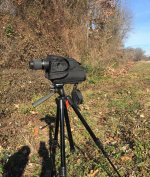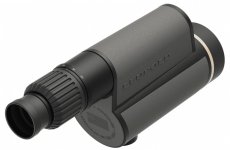Hermann
Well-known member

... are few and far between, even though they can be really useful in many situations especially when travelling or when hiking in difficult terrain. Sure, there are some products, like e.g. the Nikon ED50 or the Opticrons, but they're all flawed in one way or another. The ED50, for instance, isn't quite as robust as it needs to be in the rough and tumble of a birding trip. The small Kowa has a fixed zoom eyepiece that isn't exactly the cat's meow. And the various 60mm offerings (like the Swarovski 60mm scopes) are simply to heavy for such purposes, a weight of >1000 gr is simply too much. Add to that a decent monopod (or a lightweight tripod), and then you're talking about 2-2.5 kg. Too much for many people and in many situations.
Taking into account the number of older birders - and I'll be officially one of them when I retire at the end of the month - there must be a market for such scopes. A simple, high quality scope, with a fixed eyepiece like a 25x would be ideal in many situations. Zeiss/Hensoldt made such a scope many, many years ago: http://www.monocular.info/dialyt25x56.htm. It's long enough to lean against a tree if need be, doesn't have a complex focuser and a simple eyepiece, not a complex (and heavy) zoom. Weight is under 600 gr. including the eyepiece. The present Zeiss scope (https://www.zeiss.de/consumer-products/jagd/spektive/dialyt/dialyt-18-45x65.html) has a narrow zoom eyepiece - and weighs close to 1200 gr.
Today Swarovski, Zeiss and the other alpha makers focus on large, complex and heavy scopes. I am convinced small, light scopes would sell well. And the manufacturers would still be able to sell their big scopes no doubt - a small scope is for a different purpose.
Hermann
Taking into account the number of older birders - and I'll be officially one of them when I retire at the end of the month - there must be a market for such scopes. A simple, high quality scope, with a fixed eyepiece like a 25x would be ideal in many situations. Zeiss/Hensoldt made such a scope many, many years ago: http://www.monocular.info/dialyt25x56.htm. It's long enough to lean against a tree if need be, doesn't have a complex focuser and a simple eyepiece, not a complex (and heavy) zoom. Weight is under 600 gr. including the eyepiece. The present Zeiss scope (https://www.zeiss.de/consumer-products/jagd/spektive/dialyt/dialyt-18-45x65.html) has a narrow zoom eyepiece - and weighs close to 1200 gr.
Today Swarovski, Zeiss and the other alpha makers focus on large, complex and heavy scopes. I am convinced small, light scopes would sell well. And the manufacturers would still be able to sell their big scopes no doubt - a small scope is for a different purpose.
Hermann
Last edited:












